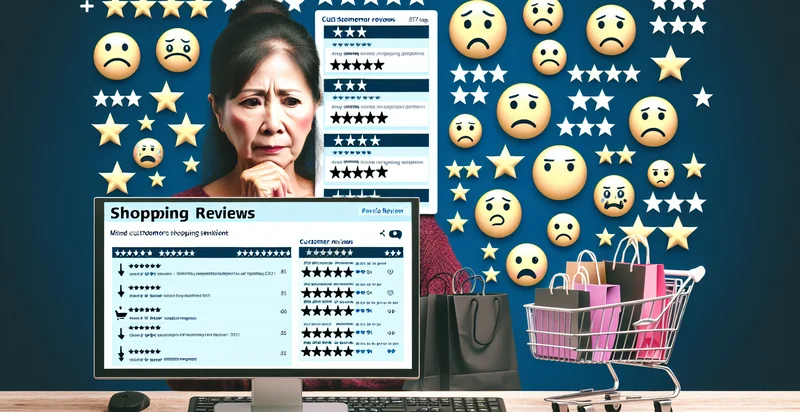Identify shopping review sentiment
using AI
Below is a free classifier to identify shopping review sentiment. Just input your text, and our AI will predict the sentiment of shopping reviews - in just seconds.

Contact us for API access
Or, use Nyckel to build highly-accurate custom classifiers in just minutes. No PhD required.
Get started
import nyckel
credentials = nyckel.Credentials("YOUR_CLIENT_ID", "YOUR_CLIENT_SECRET")
nyckel.invoke("shopping-review-sentiment", "your_text_here", credentials)
fetch('https://www.nyckel.com/v1/functions/shopping-review-sentiment/invoke', {
method: 'POST',
headers: {
'Authorization': 'Bearer ' + 'YOUR_BEARER_TOKEN',
'Content-Type': 'application/json',
},
body: JSON.stringify(
{"data": "your_text_here"}
)
})
.then(response => response.json())
.then(data => console.log(data));
curl -X POST \
-H "Content-Type: application/json" \
-H "Authorization: Bearer YOUR_BEARER_TOKEN" \
-d '{"data": "your_text_here"}' \
https://www.nyckel.com/v1/functions/shopping-review-sentiment/invoke
How this classifier works
To start, input the text that you'd like analyzed. Our AI tool will then predict the sentiment of shopping reviews.
This pretrained text model uses a Nyckel-created dataset and has 21 labels, including Content, Cynical, Disappointed, Dissatisfied, Enthusiastic, Frustrated, Happy, Hopeful, Negative and Neutral.
We'll also show a confidence score (the higher the number, the more confident the AI model is around the sentiment of shopping reviews).
Whether you're just curious or building shopping review sentiment detection into your application, we hope our classifier proves helpful.
Related Classifiers
Need to identify shopping review sentiment at scale?
Get API or Zapier access to this classifier for free. It's perfect for:
- Product Evaluation: Businesses can utilize the shopping review sentiment identifier to automatically analyze customer reviews and gauge overall product satisfaction. By categorizing sentiments as positive, negative, or neutral, they can quickly identify which products need improvement or are performing well in the market.
- Customer Feedback Loop: Companies can implement this function to gather insights from customer feedback on their shopping platforms. By understanding sentiment trends over time, businesses can adjust their offerings, product descriptions, or customer service strategies to enhance user experience.
- Marketing Strategy Optimization: The sentiment analysis can inform marketing teams about customer perceptions of their brand and products, enabling them to tailor their campaigns. Positive sentiments can be highlighted in promotional materials, while negative feedback can be addressed in messaging to regain customer trust.
- Competitive Analysis: Retailers can leverage this sentiment identifier to analyze competitors' shopping reviews, gaining insights into market positioning. By understanding the sentiment around rival products, they can better strategize their product offerings and key messaging.
- Inventory Management: By analyzing the sentiment scores from shopping reviews, companies can make more informed decisions about inventory levels. Positive sentiment can indicate a potential increase in demand, prompting proactive restocking, while negative sentiment can trigger reviews of specific inventories.
- Customer Support Prioritization: Customer support teams can use sentiment analysis to prioritize cases based on the sentiment of customer reviews. By identifying highly negative sentiments, support teams can address urgent issues more swiftly, improving customer satisfaction and retention.
- Product Development Insights: By examining the sentiments expressed in reviews, product development teams can identify features or issues that matter most to customers. This data-driven approach allows businesses to innovate and redesign products that better meet consumer expectations.


